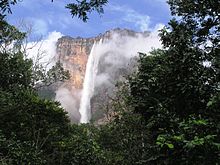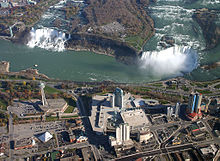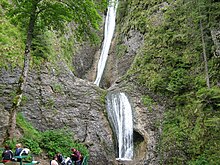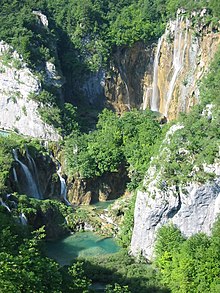Waterfall

Angel Falls in Venezuela is the world's tallest waterfall at 979 m (3,212 ft).

Frozen waterfall in southeast New York
Formation

Formation of a waterfall
Often, the rock stratum just below the more resistant shelf will be of a softer type, meaning that undercutting due to splashback will occur here to form a shallow cave-like formation known as a rock shelter or plunge pool under and behind the waterfall. Eventually, the outcropping, more resistant cap rock will collapse under pressure to add blocks of rock to the base of the waterfall. These blocks of rock are then broken down into smaller boulders by attrition as they collide with each other, and they also erode the base of the waterfall by abrasion, creating a deep plunge pool or gorge.

Baatara gorge waterfall near Tannurin, Lebanon
A river sometimes flows over a large step in the rocks that may have been formed by a fault line. Waterfalls can occur along the edge of a glacial trough, whereby a stream or river flowing into a glacier continues to flow into a valley after the glacier has receded or melted. The large waterfalls in Yosemite Valley are examples of this phenomenon, which is referred to as a hanging valley. Another reason hanging valleys may form is where two rivers join and one is flowing faster than the other.
Classification
Waterfalls are grouped into ten broad classes based on the average volume of water present on the fall using a logarithmic scale. Class 10 waterfalls include Niagara Falls, Paulo Afonso Falls and Khone Falls.Classes of other well-known waterfalls include Victoria Falls and Kaieteur Falls (Class 9); Rhine Falls, Gullfoss and Sutherland Falls (Class 8); Angel Falls and Dettifoss (Class 7); Yosemite Falls, Lower Yellowstone Falls and Umphang Thee Lor Sue Waterfall (Class 6)
Types

Dark Hollow Falls, near Skyline Drive, Virginia, is an example of a cascade waterfall
- Block: Water descends from a relatively wide stream or river.
- Cascade: Water descends a series of rock steps.
- Cataract: A large, powerful waterfall.
- Chute: A large quantity of water forced through a narrow, vertical passage
- Fan: Water spreads horizontally as it descends while remaining in contact with bedrock.
- Frozen: Any waterfall which has some element of ice.
- Horsetail: Descending water maintains some contact with bedrock.
- Plunge: Water descends vertically, losing contact with the bedrock surface.
- Punchbowl: Water descends in a constricted form and then spreads out in a wider pool.
- Segmented: Distinctly separate flows of water form as it descends.
- Tiered: Water drops in a series of distinct steps or falls.
- Multi-step: A series of waterfalls one after another of roughly the same size each with its own sunken plunge pool.
Examples of large waterfalls

Havasu Falls, near Supai, Arizona, is an example of a plunge waterfall

Powerscourt Waterfall, near Enniskerry, Wicklow County, Ireland, is an example of a horsetail waterfall

Aerial view of Niagara Falls in the state of New York, US, and province of Ontario, Canada

Duruitoarea waterfall in Ceahlău, Romania

- Angel Falls is the world's tallest at 979 metres (3212 ft) in Venezuela.
- Bambarakanda Falls is Sri Lanka's tallest waterfall at 263 m.
- Bridalveil Fall in Yosemite Valley is 189 m (620 ft) high with a sheer drop when flowing.
- Cascata delle Marmore in Italy is the tallest man-made waterfall in the world.
- Cautley Spout, at 175 m (580 ft), is the tallest waterfall in England.
- Colonial Creek Falls, the second tallest waterfall in North America at 2,584 ft (788 m), is located in the North Cascades National Park, Washington, United States.
- Dettifoss, Northeast Iceland is the largest waterfall in Europe in terms of volume discharge, having an average water flow of 200 m³/s.The falls are 100 m wide and have a drop of 44 m down to the Jökulsárgljúfur canyon.
- Eas a' Chual Aluinn, at 200 m (658 ft), is the tallest waterfall in both Scotland and the United Kingdom.
- Gocta is the fifth tallest in the world at 771 m (2532 ft) and located in the province Chachapoyas, Peru.
- Hannoki Falls is the tallest waterfall in Asia at 1,640 ft (500 m) and located in Tateyama, Japan.
- High Force on the River Tees is one of the tallest waterfalls in England.
- Huangguoshu Waterfall in Anshun, Guizhou, China, is the largest waterfall in East Asia.
- Iguazu Falls is a tall and extremely wide waterfall located in South America on the Argentina/Brazil border.
- James Bruce Falls, the tallest waterfall in North America at 840 m, is located in the Princess Louisa Marine Provincial Park, British Columbia, Canada.
- Jog Falls is India's tallest (listed as 314 ranking on the World Waterfall Database), located in Karnataka state, India.
- Jurong Falls in Singapore is an artificial waterfall.
- Kaieteur Falls (Potaro River in central Guyana), located in the Kaieteur National Park, is 226 m (741 ft).
- Krimmler Wasserfälle, at 380 m, is Austria's second tallest waterfall and located in Krimml, Salzburg, Austria.
- Multnomah Falls is 611 feet (186 m) high and 30 ft wide.
- Niagara Falls are the most powerful falls in North America.
- Pissing Mare Falls, at 350 m (1148 ft), is the tallest in eastern North America.
- Pistyll Rhaeadr, a 240 ft (73m) waterfall in Wales.
- Ramnefjellsfossen is the world's third tallest at 808 m (2685 ft), at Stryn, Nesdalen, Norway.
- Rhine Falls is Europe's widest and is located in Switzerland.
- ShirAbad Waterfall is located in Iran, Golestan, Khanbebin, Shirabad.
- Shoshone Falls the "Niagara of the West" in Idaho
- St.Clair's Falls is Sri Lanka's widest waterfall 265 ft high.
- Takakkaw Falls is a 384 m (1260 ft) in Yoho National Park in Canada.
- Tequendama Falls is a 132 m high waterfall on the Bogotá River, about 30 km southwest of Bogotá in Colombia.
- Tugela Falls is the world's second tallest at 947 m (3110 ft) in KwaZulu-Natal province, Republic of South Africa.
- Victoria Falls is the largest waterfall in the world and is more than a mile long. It is located on the Zambezi river on the border of Zimbabwe and Zambia.
- Virginia Falls (Northwest Territories) on South Nahanni River, Northwest Territories, Canada. World's 14th largest waterfall located in Nahanni National Park Reserve a UNESCO World Heritage Site.
- Waihilau Falls, at 2,600 ft (792 m), is located in the Waimanu Valley, Hawaii, United States.
- Yosemite Falls, the fourth tallest waterfall in North America at 2,425 ft (739 m), is located in Yosemite National Park, United States.
- Yumbilla Falls is the world's fifth tallest waterfall and located in Peru.
- Silver Falls is a waterfall and is located in Silverton, Oregon.




